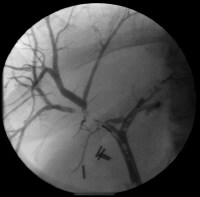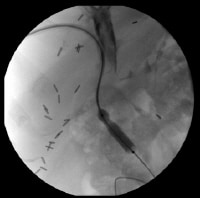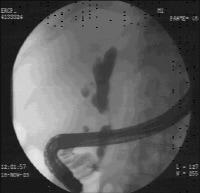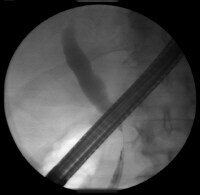Bile duct stricture (biliary stricture) is an uncommon but challenging clinical condition that requires a coordinated multidisciplinary approach involving gastroenterologists, radiologists, and surgical specialists. Unfortunately, most benign bile duct strictures (biliary strictures) are iatrogenic, resulting from operative trauma (see images below).[1] Bile duct strictures (biliary strictures) may be asymptomatic but, if ignored, can cause life-threatening complications, such as ascending cholangitis,[2, 3] liver abscess, and secondary biliary cirrhosis.
 Focal intrahepatic benign bile duct stricture after cholecystectomy.
Focal intrahepatic benign bile duct stricture after cholecystectomy.  Percutaneous transhepatic cholangiogram with balloon dilation of a postoperative bile duct stricture.
Percutaneous transhepatic cholangiogram with balloon dilation of a postoperative bile duct stricture.
However, not all bile duct strictures (biliary strictures) are benign. Pancreatic cancer is the most common cause of malignant biliary strictures (see images below).[4, 5] Most of these patients die of complications of tumor invasion and metastasis rather than from the bile duct stricture (biliary stricture) per se. Nonetheless, both benign and malignant bile duct strictures can be associated with distressing symptoms and excessive morbidity.[6]
 Endoscopic retrograde cholangiopancreatographic cholangiogram demonstrating an isolated mid-hepatic duct stricture as a result of pancreatic cancer.
Endoscopic retrograde cholangiopancreatographic cholangiogram demonstrating an isolated mid-hepatic duct stricture as a result of pancreatic cancer.  Focal bile duct stricture as a result of pancreatic cancer in the head of the pancreas.
Focal bile duct stricture as a result of pancreatic cancer in the head of the pancreas.
For excellent patient education resources, visit eMedicine's Liver, Gallbladder, and Pancreas Center and Hepatitis Center. Also, see eMedicine's patient education articles Cirrhosis and Gallstones.
 Focal intrahepatic benign bile duct stricture after cholecystectomy.
Focal intrahepatic benign bile duct stricture after cholecystectomy.  Percutaneous transhepatic cholangiogram with balloon dilation of a postoperative bile duct stricture.
Percutaneous transhepatic cholangiogram with balloon dilation of a postoperative bile duct stricture. However, not all bile duct strictures (biliary strictures) are benign. Pancreatic cancer is the most common cause of malignant biliary strictures (see images below).[4, 5] Most of these patients die of complications of tumor invasion and metastasis rather than from the bile duct stricture (biliary stricture) per se. Nonetheless, both benign and malignant bile duct strictures can be associated with distressing symptoms and excessive morbidity.[6]
 Endoscopic retrograde cholangiopancreatographic cholangiogram demonstrating an isolated mid-hepatic duct stricture as a result of pancreatic cancer.
Endoscopic retrograde cholangiopancreatographic cholangiogram demonstrating an isolated mid-hepatic duct stricture as a result of pancreatic cancer.  Focal bile duct stricture as a result of pancreatic cancer in the head of the pancreas.
Focal bile duct stricture as a result of pancreatic cancer in the head of the pancreas. For excellent patient education resources, visit eMedicine's Liver, Gallbladder, and Pancreas Center and Hepatitis Center. Also, see eMedicine's patient education articles Cirrhosis and Gallstones.
ليست هناك تعليقات:
إرسال تعليق